Elements of set theory#
ECON2125/6012 Lecture 3
Fedor Iskhakov
Announcements & Reminders
None
Plan for this lecture
We now turn to more formal / foundational ideas
Logic and proofs
Sets, operations with sets
Sequences, limits, operations with limits
Functions, properties of functions
Differentiation, Taylor series
+Analysis in \(\mathbb{R}^n\)
Mainly review of key ideas
Supplementary reading:
Simon & Blume: Appendix A1.1, A1.2, A1.3
Sundaram: Appendix A
Common symbols
\(P \implies Q\) means “\(P\) implies \(Q\)”
\(P \iff Q\) means “\(P \implies Q\) and \(Q \implies P\)”
\(\exists\) means “there exists”
\(\forall\) means “for all”
s.t. means “such that”
\(\because\) means “because” (not used very often)
\(\therefore\) means “therefore” (not used very often)
\(a := 1\) means “\(a\) is defined to be equal to 1” (alternatively \(a \equiv 1\) or \(a \stackrel{def.}{=} 1 \))
\(\mathbb{R}\) means all real numbers
\(\mathbb{N}\) means the natural numbers \(\{1, 2, \ldots \}\)
\(\mathbb{Z}\) means integers \(\{\ldots, -2,-1,0,1, 2, \ldots \}\)
\(\mathbb{Q}\) means the rational numbers (ratios of two integers)
Logic#
Let \(P\) and \(Q\) be statements, such as
\(x\) is a negative integer
\(x\) is an odd number
the area of any circle in the plane is \(-2 \pi R\)
Fact
Law of the excluded middle: Every mathematical statement is either true or false
Statement “\(P \implies Q\)” means “\(P\) implies \(Q\)”
Example
\(k\) is even \(\implies\) \(k = 2n\) for some integer \(n\)
Equivalent forms of \(P \implies Q\):
If \(P\) is true then \(Q\) is true
\(P\) is a sufficient condition for \(Q\)
\(Q\) is a necessary condition for \(P\)
If \(Q\) fails then \(P\) fails
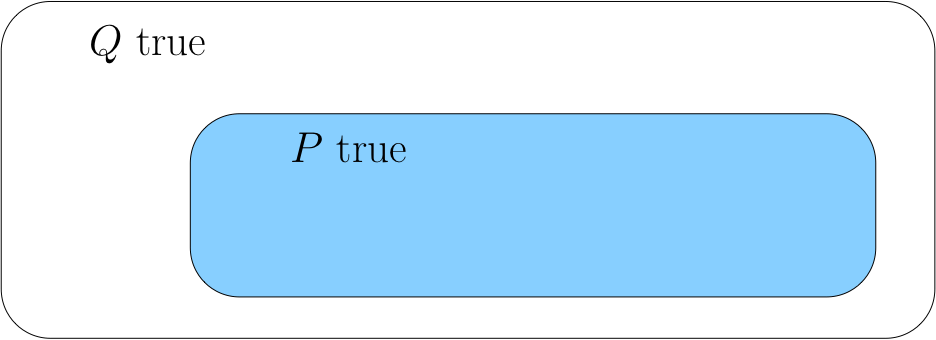
Equivalent ways of saying \(P \nRightarrow Q\) (does not imply):
\(P\) does not imply \(Q\)
\(P\) is not sufficient for \(Q\)
\(Q\) is not necessary for \(P\)
Even if \(Q\) fails, \(P\) can still hold
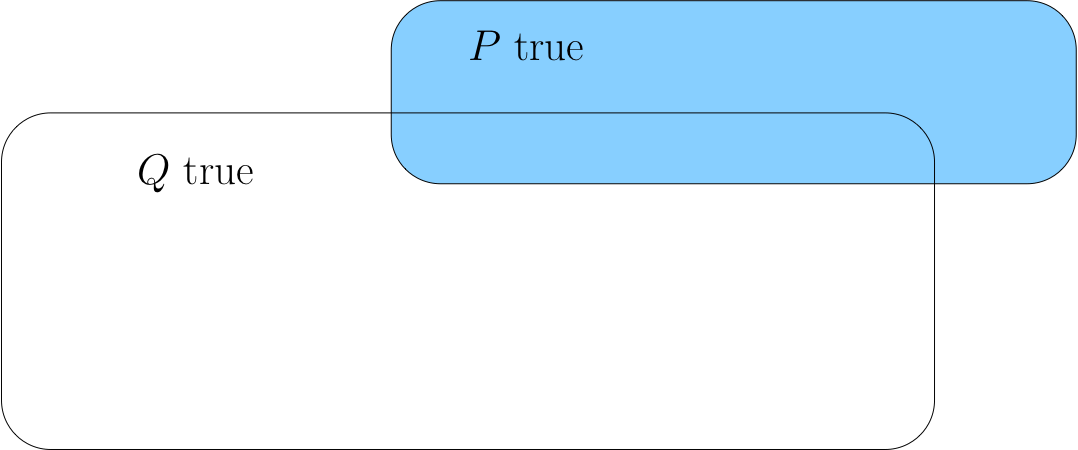
Example
Let
\(P := \) “\(n \in \mathbb{N}\) and even”
\(Q := \) “\(n\) even”
Then
\(P \implies Q\)
\(P\) is sufficient for \(Q\)
\(Q\) is necessary for \(P\)
If \(Q\) fails then \(P\) fails
Example
Let
\(P := \) “\(R\) is a rectangle”
\(Q := \) “\(R\) is a square”
Then
\(P \not \Rightarrow Q\)
\(P\) is not sufficient for \(Q\)
\(Q\) is not necessary for \(P\)
Just because \(Q\) fails does not mean that \(P\) fails
Proof by contradiction#
Suppose we wish to prove a statement such as \(P \implies Q\)
A proof by contradiction starts by assuming the opposite: \(P\) holds and yet \(Q\) fails.
We then show that this scenario leads to a contradiction
Examples of contradictions
\(1 < 0\)
\(10\) is an odd number
We then conclude that \(P \implies Q\) is valid after all.
Example: proof by contradiction
Suppose that island X is populated only by pirates and knights:
pirates always lie
knights always tell the truth
Claim to prove: If person Y says "I'm a pirate" then person Y is not a native of island X
Strategy for the Proof:
Suppose person Y is a native of the island
Show that this leads to a contradiction
Conclude that Y is not a native of island X, as claimed
Proof
Suppose to the contrary that person Y is a native of island X
then Y is either a pirate or a knight
Suppose first that Y is knight
Y is a knight who claims to be a pirate
This is impossible, since knights always tell the truth
Suppose next that Y is pirate
Y is a pirate who claims to be a pirate
Since pirates always lie, they would not make such a statement
Either way we get a contradiction \(\implies\) Y is not a native of the island!
Example
There is no \(x \in \mathbb{R}\) such that \(0 < x < 1/n\), \(\forall n \in \mathbb{N}\).
Proof
Suppose to the contrary that such an \(x\) exists

Since \(x > 0\) the number \(1/x\) is finite
Let \(k\) be the smallest integer such that \(k \geq 1/x\)
if \(x = 0.3\) then \(1/x = 3.333\cdots\), so set \(k = 4 \in \mathbb{N}\)
if \(x = 0.02\) then \(1/x = 50\cdots\), so set \(k = 50 \in \mathbb{N}\)
Since \(k \geq 1/x\) we also have \(1/k \leq x\)
On the other hand, since \(k \in \mathbb{N}\), we have \(x < 1/k\)
But then \(1/k \leq x < 1/k\), and in particular \(1/k < 1/k\), which is impossible — a contradiction!
Example
Let \(n \in \mathbb{N}\). Show that \(n^2\) odd \(\implies\) \(n\) odd
Proof
Suppose to the contrary that is:
\(n \in \mathbb{N}\) and \(n^2\) is odd
but \(n\) is even
Then \(n = 2k\) for some \(k \in \mathbb{N}\)
Hence \(n^2 = (2k)^2\)
But then \(n^2 = 2m\) for \(m := 2k^2 \in \mathbb{N}\), and thus \(n^2\) is even!
Contradiction
Sets#
Will often refer to the real numbers, \(\mathbb{R}\)
Understand it to contain “all of the numbers” on the “real line”

Contains both the rational and the irrational numbers
\(\mathbb{R}\) is an example of a set
A set is a collection of objects viewed as a whole
(In case of \(\mathbb{R}\), the objects are numbers)
Other examples of sets:
set of all rectangles in the plane
set of all prime numbers
set of students in the class
Notation:
Sets: \(A, B, C\)
Elements: \(x,y,z\)
Important sets:
\(\mathbb{N} := \{1, 2, 3, \ldots \}\)
\(\mathbb{Z} := \{\ldots, -2, -1, 0, 1, 2, \ldots \}\)
\(\mathbb{Q} := \{ p/q : p, q \in \mathbb{Z}, \; q \ne 0 \}\)
\(\mathbb{R} := \mathbb{Q} \cup \{ \text{ irrationals } \}\)
Definition of a set
A set \(A\) can be defined by either
direct enumeration of its elements
defining a formula for infinite number of elements
as a subset of already defined set \(B\) and known function \(\psi(x)\)
Intervals of \(\mathbb{R}\)#
Common notation:
Etc.
Operations with sets#
Let \(A\) and \(B\) be any sets
Statement \(x \in A\) means that \(x\) is an element of \(A\)
\(A \subset B\) means that any element of \(A\) is also an element of \(B\)
Example
\(\mathbb{N} \subset \mathbb{Z}\)
irrational numbers are a subset of \(\mathbb{R}\)
Equality of \(A\) and \(B\)
Let \(S\) be any set and \(A\) and \(B\) be subsets of \(S\)
\(A = B\) means that \(A\) and \(B\) contain the same elements
Equivalently, \(A = B\) \(\iff\) \(A \subset B\) and \(B \subset A\)
Definition
Union of \(A\) and \(B\)
Intersection of \(A\) and \(B\)
Set theoretic difference of \(A\) and \(B\)
In other words, all points in \(A\) that are not points in \(B\)
Example
\(\mathbb{Z} \setminus \mathbb{N} = \{\ldots, -2, -1, 0\}\)
\(\mathbb{R} \setminus \mathbb{Q} = \) the set of irrational numbers
\(\mathbb{R} \setminus [0, \infty) = (-\infty, 0)\)
\(\mathbb{R} \setminus (a, b) = (-\infty, a] \cup [b, \infty)\)
Definition
Complement of \(A\)
All elements of \(S\) that are not in \(A\):
Remarks:
Need to know what \(S\) is before we can determine \(A^c\)
If not clear better write \(S \setminus A\)
Example
\((a,\infty)^c\) generally understood to be \((-\infty, a]\)
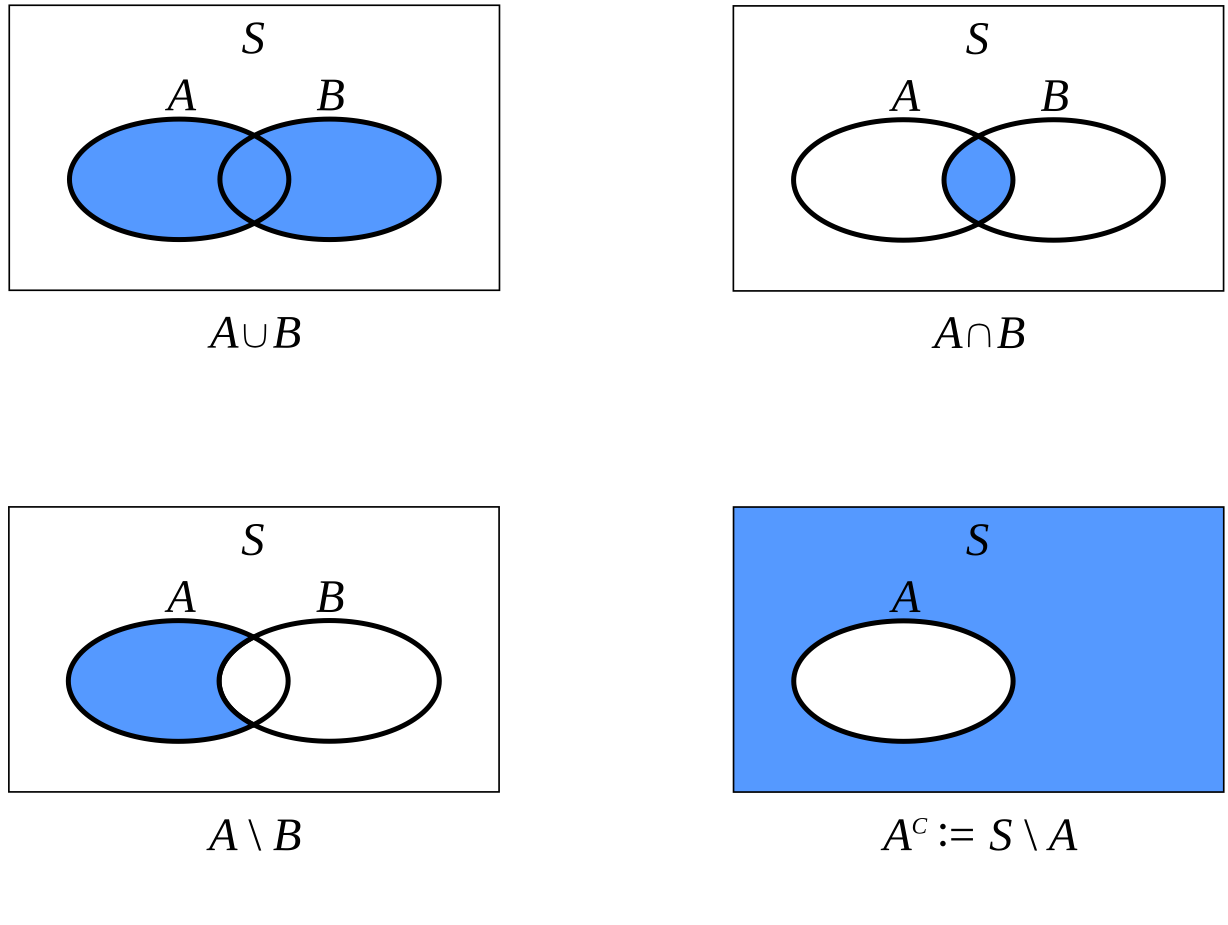
Fig. 21 \label{f:allsets} Unions, intersections and complements#
Set operations properties#
If \(A\) and \(B\) subsets of \(S\), then
\(A \cup B = B \cup A\) and \(A \cap B = B \cap A\)
\((A \cup B)^c = B^c \cap A^c\) and \((A \cap B)^c = B^c \cup A^c\)
\(A \setminus B = A \cap B^c\)
\((A^c)^c = A\)
The empty set \(\emptyset\) is the set containing no elements
If \(A \cap B = \emptyset\), then \(A\) and \(B\) said to be disjoint
Infinite Unions and Intersections#
Given a family of sets \(K_{\lambda} \subset S\) with \(\lambda \in \Lambda\),
“there exists” means “there exists at least one”
Example
Let \(A := \cap_{n \in \mathbb{N}} (0, 1/n)\)
Claim: \(A = \emptyset\)
Proof
We need to show that \(A\) contains no elements
Suppose to the contrary that \(x \in A = \cap_{n \in \mathbb{N}} (0, 1/n)\)
Then \(x\) is a number satisfying \(0 < x < 1/n\) for all \(n \in \mathbb{N}\)
No such \(x\) exists as we showed above. Contradiction.
Example
For any \(a < b\) we have \(\cup_{\epsilon > 0 } \; [a + \epsilon, b) = (a, b)\)
Proof
To show equality of the sets, we show that RHS \(\subset\) LHS and LHS \(\subset\) RHS
Pick any \(a < b\)
Suppose first that \(x \in \cup_{\epsilon > 0 } \; [a + \epsilon, b)\)
This means there exists \(\epsilon > 0\) such that \(a + \epsilon \leq x < b\)
Clearly \(a < x < b\), and hence \(x \in (a, b)\)
Conversely, if \(a < x < b\), then \(\exists \, \epsilon > 0\) s.t. \(a + \epsilon \leq x < b\)
Hence \(x \in \cup_{\epsilon > 0 } \; [a + \epsilon, b)\)
Fact: de Morgan’s laws
Let \(S\) be any set and let \(K_{\lambda} \subset S\) for all \(\lambda \in \Lambda\). Then
Let’s prove that \(A := \left( \cup_{\lambda \in \Lambda} K_{\lambda} \right)^{c} = \cap_{\lambda \in \Lambda} K_{\lambda}^{c} =: B\)
Suffices to show that \(A \subset B\) and \(B \subset A\)
Let’s just do \(A \subset B\)
Must show that every \(x \in A\) is also in \(B\)
Fix \(x \in A\)
Since \(x \in A\), it must be that \(x\) is not in \(\cup_{\lambda \in \Lambda} K_{\lambda}\)
Tuples#
We often organize collections with natural order into “tuples”
Definition
A tuple is
a finite ordered sequence of terms
denoted using notation such as \((a_1, a_2)\) or \((x_1, x_2, x_3)\)
Example
Flip a coin 10 times and let
\(0\) represent tails and \(1\) represent heads
Typical outcome \((1, 1, 0, 0, 0, 0, 1, 0, 1, 1)\)
Generic outcome \((b_1, b_2, \ldots, b_{10})\) for \(b_n \in \{0, 1\}\)
Cartesian Products#
We make collections of tuples using Cartesian products
Definition
The Cartesian product of \(A_1, \ldots, A_N\) is the set
Example

Example
Set of all outcomes from flip experiment is
Example
The vector space \(\mathbb{R}^N\) is the Cartesian product
Counting Finite Sequences#
Counting methods answer common questions such as
How many arrangements of a sequence?
How many subsets of a set?
They also address deeper problems such as
How “large” is a given set?
Can we compare size of sets even when they are infinite?
The key rule is: multiply possibilities
Example
Can travel from Sydney to Tokyo in 3 ways and Tokyo to NYC in 8 ways \(\implies\) can travel from Sydney to NYC in 24 ways
Example
Number of 10 letter passwords from the lowercase letters a,b,...,z is
Example
Number of possible distinct outcomes \((i, j)\) from 2 rolls of a dice is
Counting Cartesian Products#
Fact
If \(A_n\) are finite for \(n=1, \ldots,N\), then
That is, number of possible tuples \(=\) product of the number of possibilities for each element
Example
Number of binary sequences of length \(10\) is
Infinite Cartesian Products
If \(\{A_n\}\) is a collection of sets, one for each \(n \in \mathbb{N}\), then
Sometimes denoted \(\times_{n=1}^{\infty} A_n\)
If \(A_n = A\) for all \(n\), then \(\times_{n=1}^{\infty} A\) also written as \(A^{\mathbb{N}}\)
Example
The set of all binary sequences \(\{0, 1\}^{\mathbb{N}}\)
Functions#
Definition
A function \(f \colon A \rightarrow B\) from set \(A\) to set \(B\) is a rule that associates to each element of \(A\) a uniquely determined element of \(B\)
\(f \colon A \to B\) means that \(f\) is a function from \(A\) to \(B\)

\(A\) is called the domain of \(f\) and \(B\) is called the codomain
Example
\(f\) defined by
is a function from \(\mathbb{R}\) to \(\mathbb{R}\)
Sometimes we write the whole thing like this

Lower panel: functions have to map all elements in domain to a uniquely determined element in codomain.
Definition
For each \(a \in A\), \(f(a) \in B\) is called the image of \(a\) under \(f\)
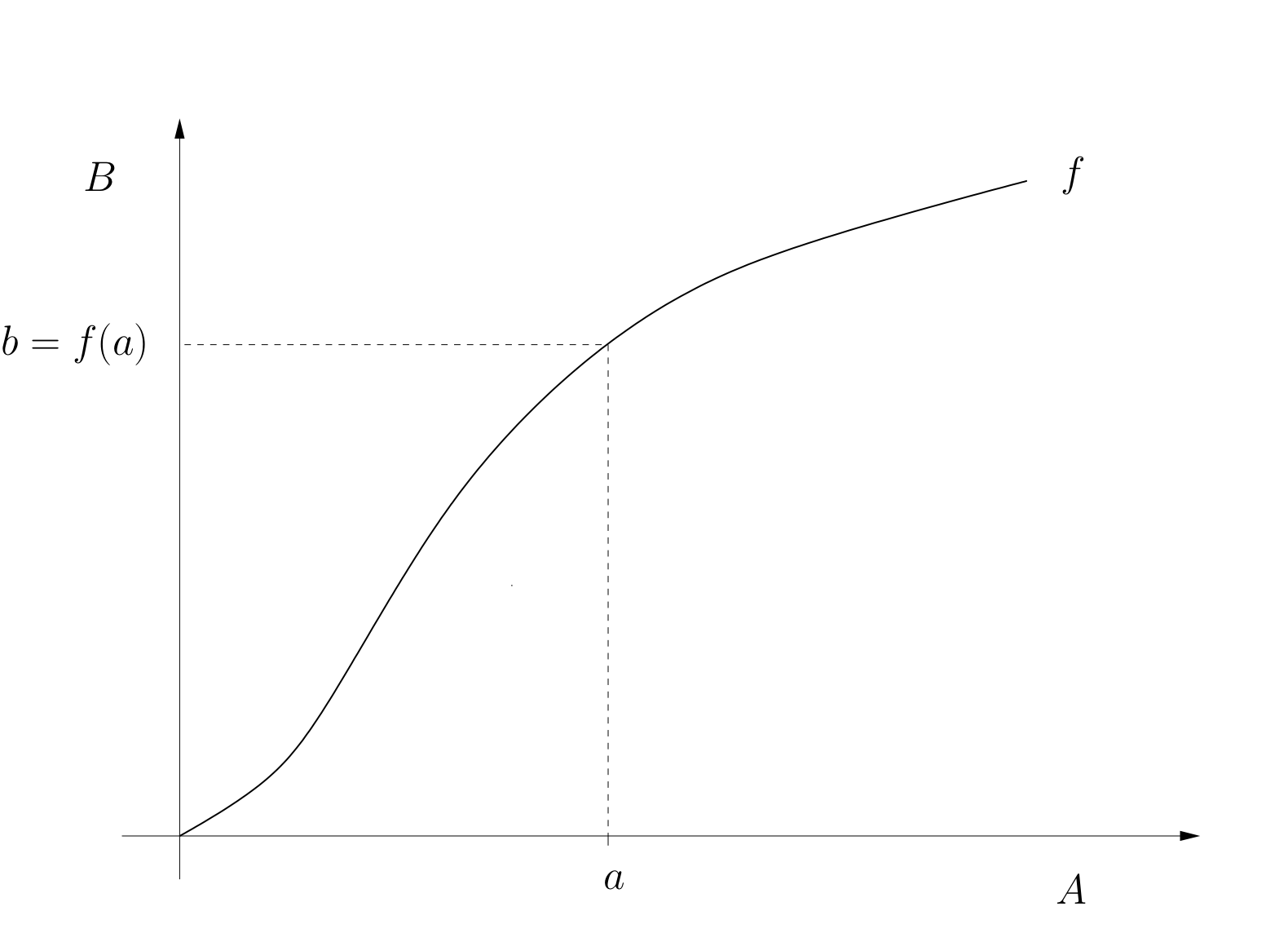
If \(f(a) = b\) then \(a\) is called a preimage of \(b\) under \(f\)

A point in \(B\) can have one, many or zero preimages

The codomain of a function is not uniquely pinned down
Example
Consider the mapping defined by \(f(x) = \exp(-x^2)\)
Both of these statements are valid:
\(f\) a function from \(\mathbb{R}\) to \(\mathbb{R}\)
\(f\) a function from \(\mathbb{R}\) to \((0, \infty)\)
Definition
The smallest possible codomain is called the range of \(f \colon A \to B\):
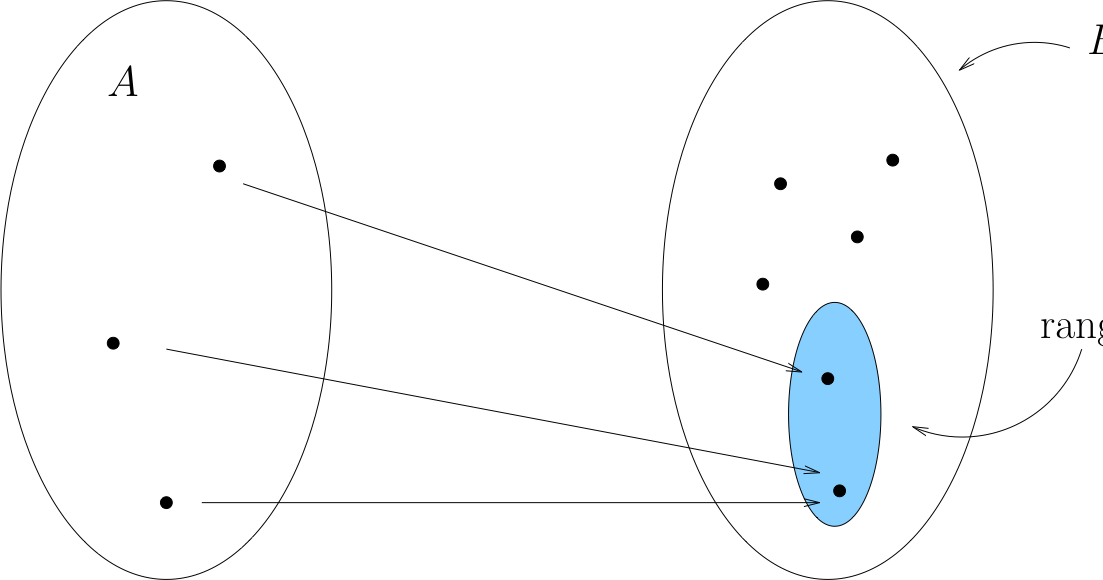
Example
Let \(f \colon [-1, 1] \to \mathbb{R}\) be defined by
Then \(\mathrm{rng}(f) = [0.8, 2.0]\)
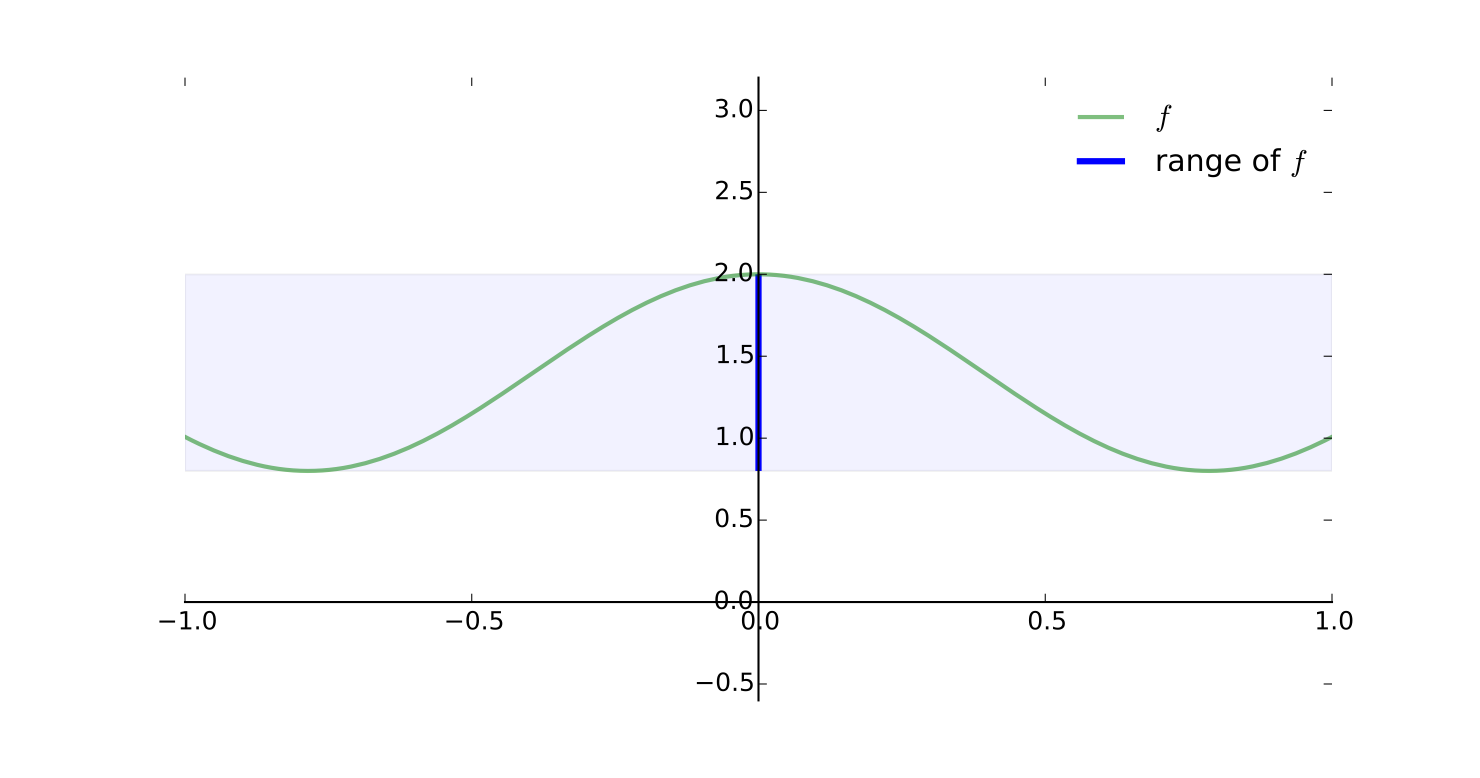
Example
If \( f \colon [0, 1] \to \mathbb{R}\) is defined by
then \(\mathrm{rng}(f) = [0, 2]\)
Example
If \(f \colon \mathbb{R} \to \mathbb{R}\) is defined by
then \(\mathrm{rng}(f) = (0, \infty)\)
Proof
The composition of \(f \colon A \to B\) and \(g \colon B \to C\) is the function \(g \circ f\) from \(A\) to \(C\) defined by

Onto Functions (Surjections)#
Definition
A function \(f \colon A \to B\) is called onto (or surjection) if every element of \(B\) is the image under \(f\) of at least one point in \(A\).
Equivalently, \(\mathrm{rng}(f) = B\)

Fact
\(f \colon A \to B\) is onto if and only if each element of \(B\) has at least one preimage under \(f\)

Fig. 22 Onto (surjection)#

Fig. 23 Not onto!#

Fig. 24 Not onto!#
Example
The function \(f \colon \mathbb{R} \to \mathbb{R}\) defined by
is onto whenever \(a \ne 0\)
To see this pick any \(y \in \mathbb{R}\)
We claim \(\exists \; x \in \mathbb{R}\) such that \(f(x) = y\)
Equivalent:
Fact
Every cubic equation with \(a \ne 0\) has at least one real root
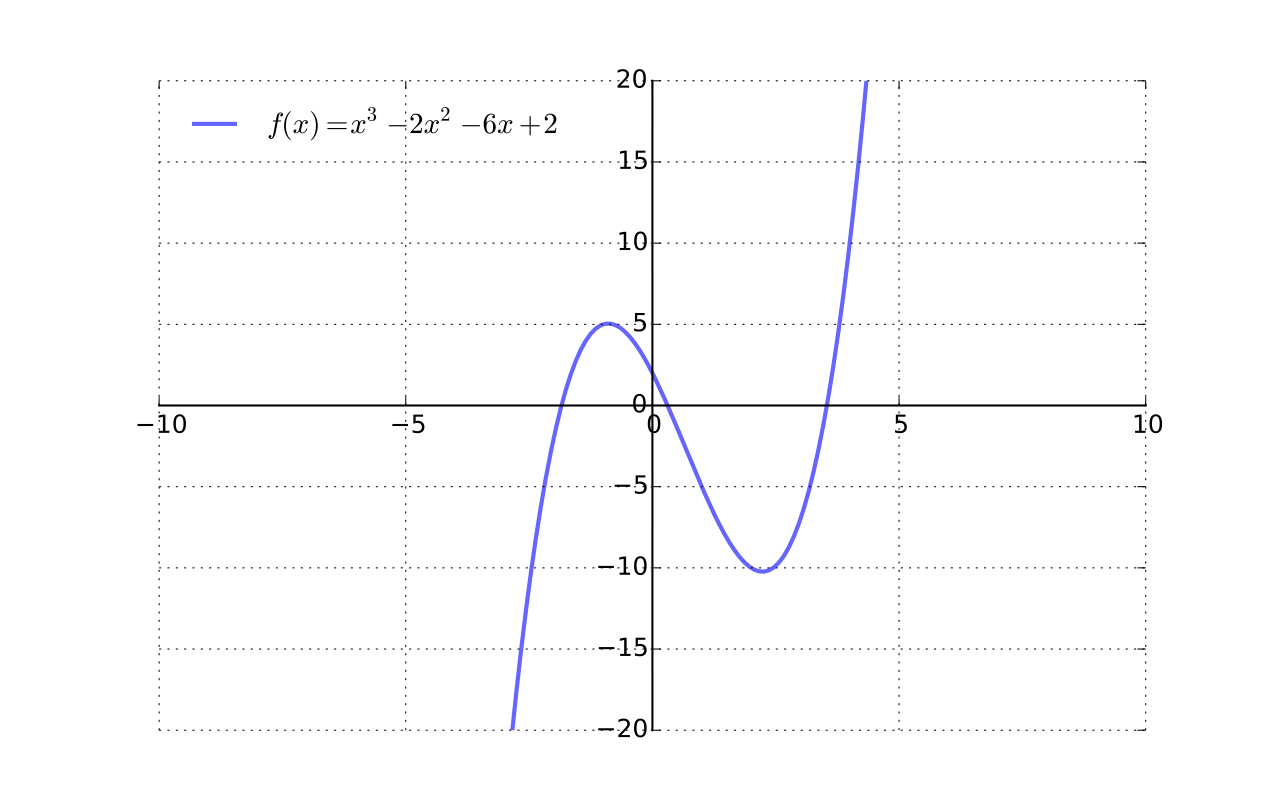
Fig. 25 Cubic functions from \(\mathbb{R}\) to \(\mathbb{R}\) are always onto#
One-to-One Functions (Injections)#
Definition
A function \(f \colon A \to B\) is called one-to-one (or injection) if distinct elements of \(A\) are always mapped into distinct elements of \(B\).
That is, \(f\) is one-to-one if
Equivalently,
Fact
\(f \colon A \to B\) is one-to-one if and only if each element of \(B\) has at most one preimage under \(f\)

Fig. 26 One-to-one#

Fig. 27 One-to-one#

Fig. 28 Not one-to-one#
Bijections#
Definition
A function that is
one-to-one (injection) and
onto (surjection)
is called a bijection or one-to-one correspondence

Fact
\(f \colon A \to B\) is a bijection if and only if each \(b \in B\) has one and only one preimage in \(A\)
Example
\(x \mapsto 2x\) is a bijection from \(\mathbb{R}\) to \(\mathbb{R}\)
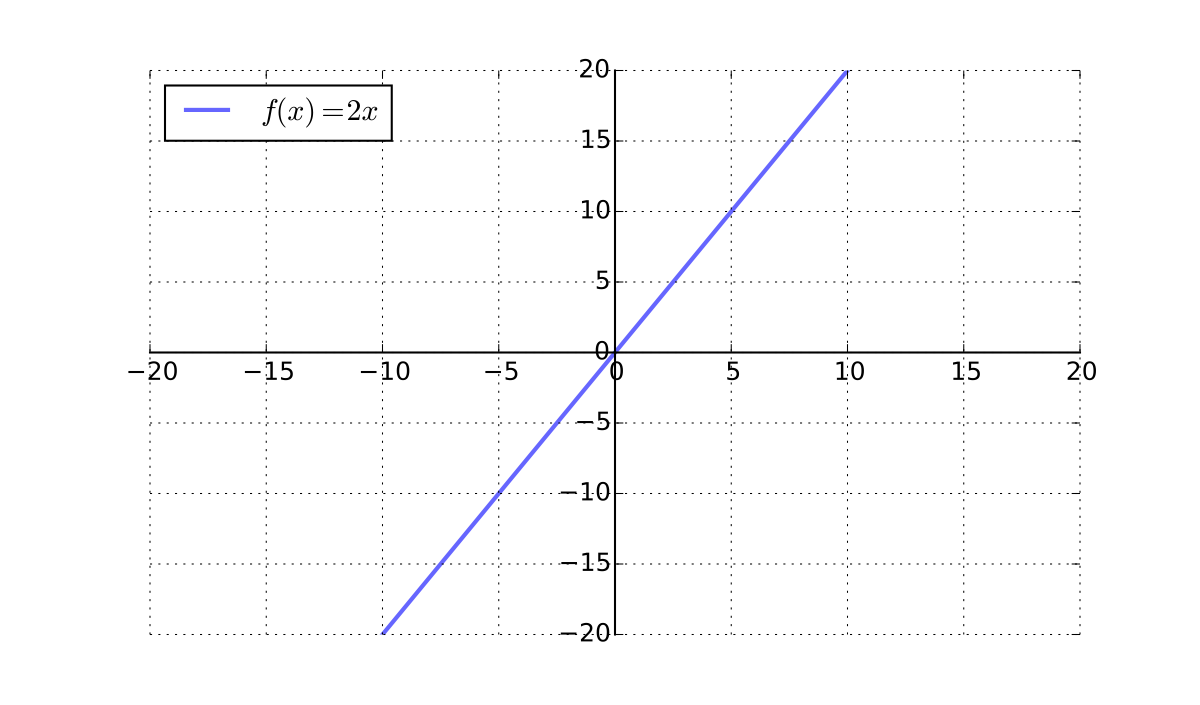
Example
\(k \mapsto -k\) is a bijection from \(\mathbb{Z}\) to \(\mathbb{Z}\)
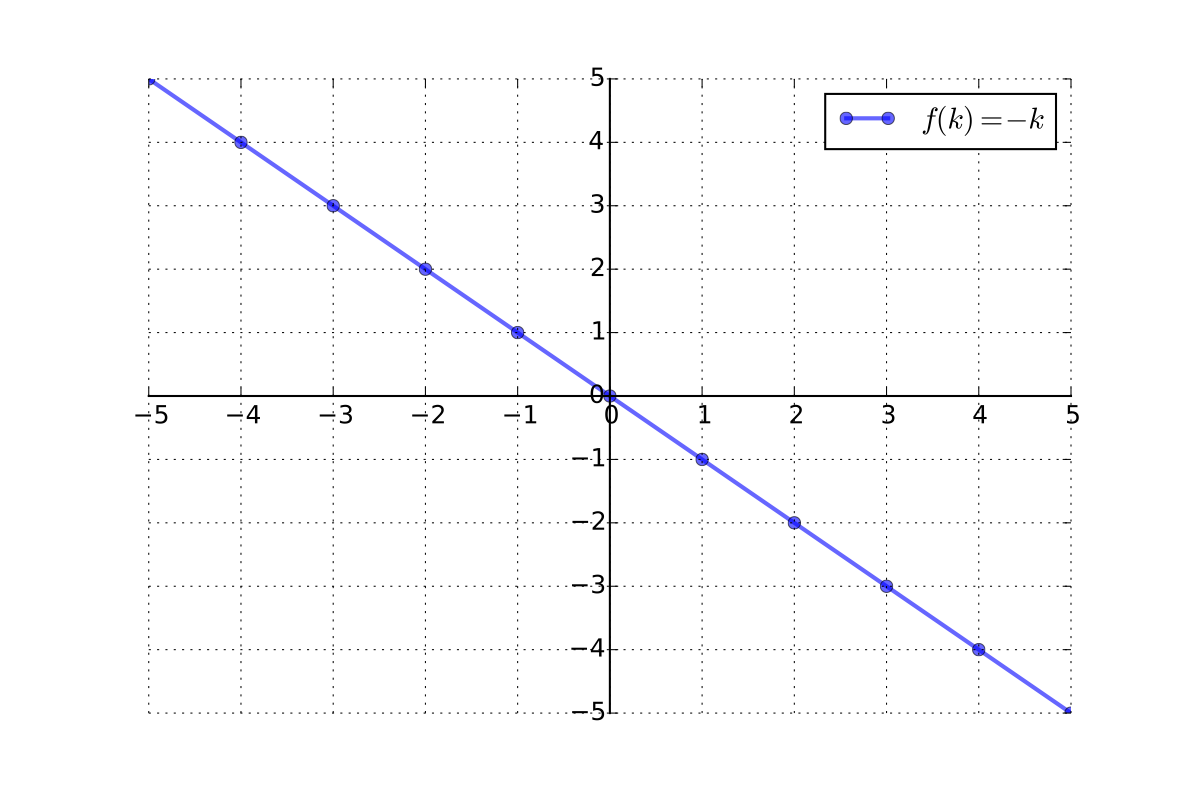
Example
\(x \mapsto x^2\) is not a bijection from \(\mathbb{R}\) to \(\mathbb{R} \)

Fact
If \(f \colon A \to B\) a bijection, then there exists a unique function \(\phi \colon B \to A\) such that
That function \(\phi\) is called the inverse of \(f\) and written \(f^{-1}\)

Example
Let
\(f \colon \mathbb{R} \to (0, \infty)\) be defined by \(f(x) = \exp(x) := e^x\)
\(\phi \colon (0, \infty) \to \mathbb{R}\) be defined by \(\phi(x) = \log(x)\)
Then \(\phi = f^{-1}\) because, for any \(a \in \mathbb{R}\),
Fact
If \(f \colon A \to B\) is one-to-one, then \(f \colon A \to \mathrm{rng}(f)\) is a bijection
Fact
Let \(f \colon A \to B\) and \(g \colon B \to C\) be bijections
\(f^{-1}\) is a bijection and its inverse is \(f\)
\(f^{-1}(f(a)) = a\) for all \(a \in A\)
\(f(f^{-1}(b)) = b\) for all \(b \in B\)
\(g \circ f\) is a bijection from \(A\) to \(C\) and \((g \circ f)^{-1} = f^{-1} \circ g^{-1}\)

Fig. 29 Illustration of \((g \circ f)^{-1} = f^{-1} \circ g^{-1}\)#
Cardinality#
If a bijection exists between sets \(A\) and \(B\) they are said to have the same cardinality, and we write \(|A| = |B|\)
Fact
If \(|A| = |B|\) and \(A\) and \(B\) are finite then \(A\) and \(B\) have the same number of elements (same cardinality).
Exercise: Convince yourself this is true
Hence “same cardinality” is analogous to “same size”
But cardinality applies to infinite sets as well!
Fact
If \(|A| = |B|\) and \(|B| = |C|\) then \(|A| = |C|\)
Proof
Since \(|A| = |B|\), there exists a bijection \(f \colon A \to B\)
Since \(|B| = |C|\), there exists a bijection \(g \colon B \to C\)
Let \(h := g \circ f\)
Then \(h\) is a bijection from \(A\) to \(C\)
Hence \(|A| = |C|\)
Definition
A nonempty set \(A\) is called finite if
Otherwise called infinite
Definition
Sets that either are finite, or have the same cardinality as \(\mathbb{N}\) (denoted \(|A| = \aleph_0\)) are called countable.
Example
\(-\mathbb{N} := \{\ldots, -4, -3, -2, -1\}\) is countable
Formally: \(f(k) = -k\) is a bijection from \(-\mathbb{N}\) to \(\mathbb{N}\)
Example
\(E := \{2, 4, \ldots\}\) is countable
Formally: \(f(k) = k/2\) is a bijection from \(E\) to \(\mathbb{N}\)
Example
\(\{100, 200, 300, \ldots\}\) is countable
Fact
Nonempty subsets of countable sets are countable
Fact
Finite unions of countable sets are countable
Sketch of proof, for
\(A\) and \(B\) countable \(\implies A \cup B\) countable
\(A\) and \(B\) are disjoint and infinite
By assumption, can write \(A = \{a_1, a_2, \ldots\}\) and \(B = \{b_1, b_2, \ldots\}\)
Now count it like so:
Example
\(\mathbb{Z} = \{\ldots, -2, -1\} \cup \{ 0 \} \cup \{1, 2, \ldots\}\) is countable
Fact
Finite Cartesian products of countable sets is countable
Sketch of proof, for
\(A\) and \(B\) countable \(\implies A \times B\) countable
\(A\) and \(B\) are disjoint and infinite
Now count like so:
Example
\(\mathbb{Z} \times \mathbb{Z} = \{ (p,q) : p \in \mathbb{Z}, q \in \mathbb{Z} \}\) is countable

Fact
\(\mathbb{Q}\) is countable
Proof
By definition
Consider the function \(\phi\) defined by \(\phi(p/q) = (p, q)\)
A one-to-one function from \(\mathbb{Q}\) to \(\mathbb{Z} \times \mathbb{N}\)
A bijection from \(\mathbb{Q}\) to \(\mathrm{rng}(\phi)\)
Since \(\mathbb{Z} \times \mathbb{N}\) is countable, so is \(\mathrm{rng}(\phi) \subset \mathbb{Z} \times \mathbb{N}\)
Hence \(\mathbb{Q}\) is also countable
Example
An example of an uncountable set is all binary sequences
Sketch of proof: If this set were countable then it could be listed as follows:
Such a list is never complete: Cantor’s diagonalization argument
Cardinality of \(\{0,1\}^{\mathbb{N}}\) called the power of the continuum
Other sets with the power of the continuum
\(\mathbb{R}\)
\((a, b)\) for any \(a < b\)
\([a, b]\) for any \(a < b\)
\(\mathbb{R}^N\) for any finite \(N \in \mathbb{N}\)
Continuum hypothesis
Every nonempty subset of \(\mathbb{R}\) is either countable or has the power of the continuum
Example
\(\mathbb{R}\) and \((-1, 1)\) have the same cardinality because \(x \mapsto 2\arctan(x)/\pi\) is a bijection from \(\mathbb{R}\) to \((-1, 1)\)
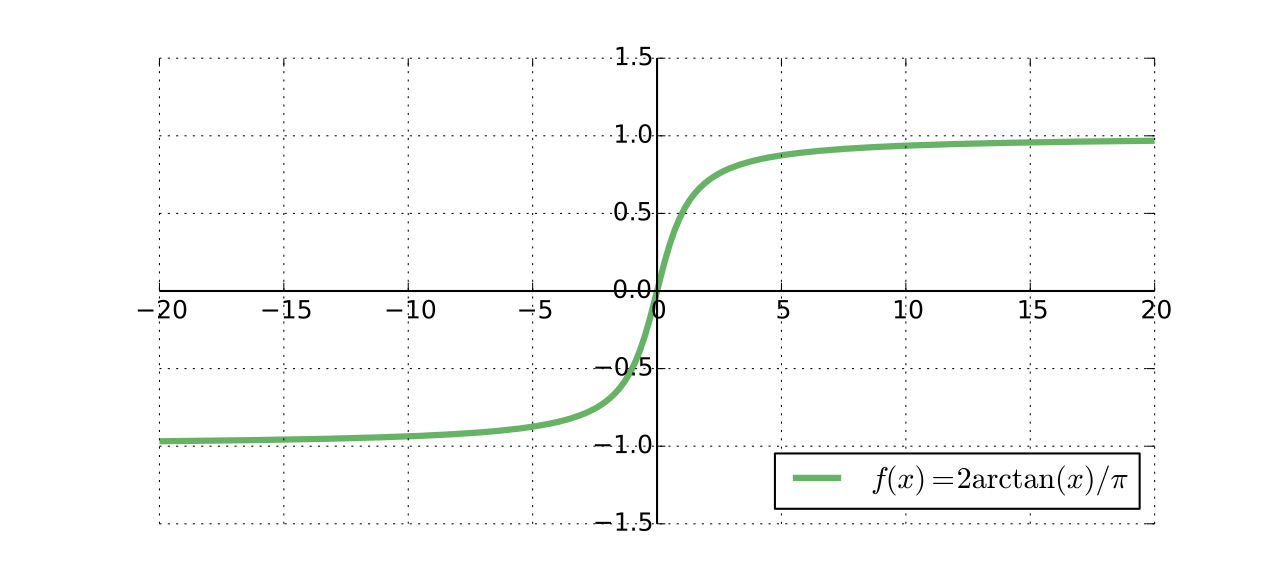
Fig. 30 Same cardinality#
Extra material#
Veritasium video on paradoxes of set theory and mathematical incompleteness YouTube

